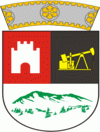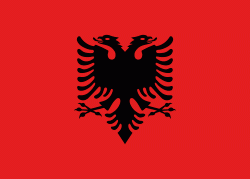Berat County (Qarku i Beratit)
 |
Archaeologists have found artifacts including silver women's earrings and bronze belt-buckles in Bronze Age tumuli in Pëllumbas, one of the villages of Berat. These items are similar to other artifacts found in northern Albania (Kukës and Mat), Kosovo (Gjilan) and northwestern Greece (Pogoni).
Antipatrea (Ἀντιπάτρεια) was an ancient Greek polis in Illyria, now Berat. It was founded by Cassander as Antipatreia, who named it after his father Antipater at 314 BC. An ancient Greek fortress and settlement are still visible today. Dassaretae tribe existed in the area, as early as the 6th century BC. It was captured by the Romans in the 2nd century BC. Livy (31.27.2) describes Antipatrea as a strongly fortified city in a narrow pass that the Romans sacked and burned. The city was composed of two fortifications on both banks of the Osum River.
Historical manuscripts such as the 6th century Codex Purpureus Beratinus, discovered in 1868, and the Codex Aureus, a 9th-century Greek language manuscript have revealed much about the history of the region and that Berat had a reputation for producing manuscripts; 76 of the 100 codes protected in the National Archives of Albania are from Berat, indicating its historical importance.
The town of Berat became part of the unstable frontier of the Byzantine Empire following the fall of the Roman Empire and, along with much of the rest of the Balkan peninsula, it suffered from repeated invasions by Slavs and other tribes. During the Byzantine period, it was known as Pulcheriopolis.
The Bulgarians under Simeon I captured the town in the 9th century and renamed it Beligrad (White City). They were eventually driven out in the 11th century. During the 13th century, it fell to Michael I Ducas, the ruler of the Despotate of Epirus.
In the latter part of the 13th century, Berat again came under the control of the Byzantine Empire. In 1272 Berat was captured by the forces of the Kingdom of Albania, while Michael VIII Palaiologos sent letters to the Albanian leaders of Berat and Durrës asking them to abandon their alliance with Charles I of Naples; they sent the letters to Charles as a sign of their loyalty.
In 1274 Michael VIII recaptured Berat and after being joined by Albanians, who supported the Byzantine Empire marched unsuccessfully against the Angevin capital of Durrës.
In 1280–1281, the Sicilian forces under Hugh the Red of Sully laid siege to Berat. In March 1281, a relief force from Constantinople under the command of Michael Tarchaneiotes was able to drive off the besieging Sicilian army. In 1335–1337, Albanian tribes took control of the area between Berat and Vlorë for the first time, that time the Muzakaj formed the Lordship of Berat. Serbs took control of the area in 1345. Later, it passed back into the hands of Muzaka, restoring the Lordship, until 1450.
The Ottoman Empire conquered it in 1450 from the Muzaka family. Skanderbeg's Albanian forces unsuccessfully besieged the fort in 1455. It remained under Ottoman control until 1912, when it became part of Albania. Ali Pasha (born 1744-died 1822), an Ottoman Albanian ruler, took control of Berat between 1788 and 1822, as a semi-autonomous ruler. His domain was called the Pashalik of Yanina. He refortified the city in 1809. In 1867, Berat became a sanjak in the Janina (Yanya) vilayet. During Ottoman rule, it was known Arnavut Belgradı in Turkish (meaning "Albanian Belgrade") at first and then Berat.
Map - Berat County (Qarku i Beratit)
Map
Country - Albania
 |
 |
| Flag of Albania | |
Albania has been inhabited by different civilisations over time, such as the Illyrians, Thracians, Ancient Greeks, Romans, Byzantines, Venetians, and Ottomans. The Albanians established the autonomous Principality of Arbër in the 12th century. The Kingdom of Albania and Principality of Albania formed between the 13th and 14th centuries. Prior to the Ottoman conquest of Albania in the 15th century, the Albanian resistance to Ottoman expansion into Europe led by Skanderbeg won them acclaim over most of Europe. Albania remained under Ottoman rule for nearly five centuries, during which many Albanians (known as Arnauts) attained high-ranking offices in the empire, especially in the Southern Balkans and Egypt. Between the 18th and 19th centuries, cultural developments, widely attributed to Albanians having gathered both spiritual and intellectual strength, conclusively led to the Albanian Renaissance. After the defeat of the Ottomans in the Balkan Wars, the modern nation state of Albania declared independence in 1912. In the 20th century, the Kingdom of Albania was invaded by Italy, which formed Greater Albania before becoming a protectorate of Nazi Germany. Enver Hoxha formed the People's Socialist Republic of Albania after World War II, modeled under the terms of Hoxhaism. The Revolutions of 1991 concluded the fall of communism in Albania and eventually the establishment of the current Republic of Albania.
Currency / Language
| ISO | Currency | Symbol | Significant figures |
|---|---|---|---|
| ALL | Albanian lek | L | 2 |
| ISO | Language |
|---|---|
| SQ | Albanian language |
| EL | Greek language |















